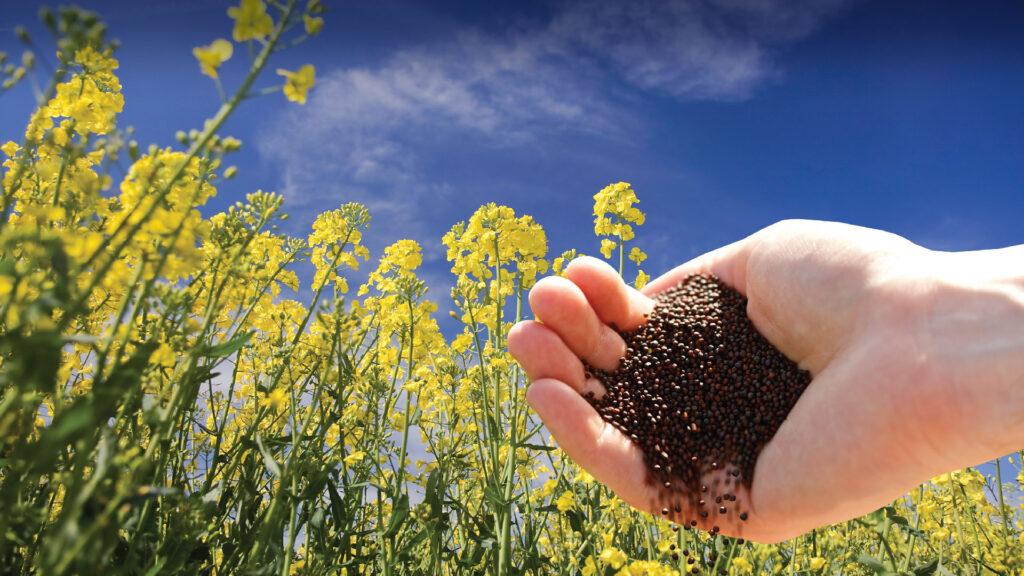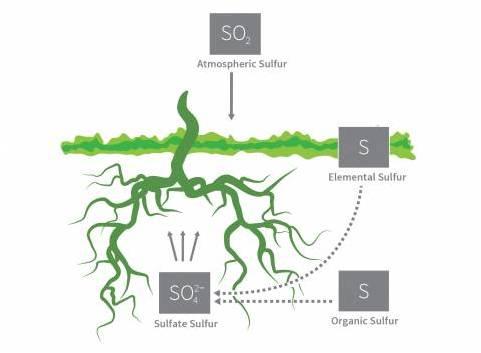
Sulfur (S) – The Crucial Nutrient for Oilseed Crops
Sulfur (S) is found in all living cells and is essential for the synthesis of proteins. But often, there is not enough of it to meet the demands of crops with high yields. Sulfur is sometimes referred to as “the fourth major nutrient,” even though it is classified as a secondary element along with calcium and magnesium.
In contrast to other secondary nutrients like calcium and magnesium, which plants absorb as cations, S is absorbed by the plants primarily as the SO₄²⁻ anion.

Source of Sulfur for the Crop Plant –
Elemental S: In order for plants to utilize it, it needs to be oxidized to sulfate. Particle size, aeration, moisture content, and temperature all have an impact on this biological process. Acidity is also produced by this process and elemental S can be used specifically to acidify soils in some situations.

Organic S: Before crops can absorb it, it needs to mineralize into the inorganic sulfate anion. Temperature and moisture have an impact on the decomposition of organic matter and the subsequent release of S. In general, favorable conditions for crop growth also favor mineralization and S release, though this may be less likely with cool-season crops.
Atmospheric S: The industrial area is associated with a higher concentration of SO₂ in the atmosphere. Sulfur also comes from burning fuel. Sulfur dioxide (SO₂), a form of sulfur, is released. Rainwater dissolves this SO₂ before it eventually reaches the soil. It can also enter plant leaves through the atmosphere as sulfur dioxide (SO₂) gas.
Sulfur and Its Importance in Oilseed Crops –
In general, one of the most significant crops in the world is Oilseed. One cannot undervalue their significance in the human diet and industrial applications. Oil palm, sesame, rapeseed, sunflower, safflower, olive seed, coconut, and soy are some of the main Oilseed crops.
The world’s biggest producer and user of vegetable oil is India. India’s agricultural economy has long been based primarily on Oilseeds. Growing annual Oilseed crops, which include 2 non-edible Oilseeds (castor and linseed) and 7 edible Oilseeds (groundnut, rapeseed, mustard, soybean, sunflower, sesame, safflower, and Niger), is made possible by the country’s varied agro-ecological conditions.
Compared to other crops, Oilseeds require more sulfur, and their uptake and concentration depend on the amount of sulfur present in the soil. Sulfur is just as essential to Oilseed crops overall as phosphorus is.
Compared to other crops, Oilseeds need a higher concentration of S for growth and development. Sulfur is a macro-nutrient that is vital to all crops, but it is especially important for Oilseed crops because it increases the yield of oil content and the content of essential amino acids. Sufficient Sulfur feeding increases seed yield and oil content in the plants.
Sulfur’s Function in Plants –
- Sulfur is necessary for the synthesis of proteins, amino acids and oils.
- Synthesis of oils, which is why adequate sulfur is so crucial for Oilseeds.
- S encourages nodulation in legumes and is important to produce chlorophyll.
- S aids in the growth and activation of specific enzymes and vitamins.
- Sulfur is a constituent of 3 S – containing amino acids (cysteine, cystine and methionine), which are the building blocks of protein.
Crop Deficit in Sulfur –
It is not unexpected that S and N are linked as both are necessary for the synthesis of protein and chlorophyll. They are also related by sulfur’s role in the transformation of nitrate into amino acids. Crops with high N requirements typically have high S requirements as well.
Widespread sulfur deficiencies in arable soils were caused using fertilizers with low sulfur content, heavy sulfur removal by crops grown under intensive cultivation, and neglect of sulfur replenishment.
Plants cultivated in soil low in sulfur exhibit reduced sulfur content and inadequate uptake of N, P and K. Younger leaves of plants that are deficient in sulfur turn pale green, yellowish green or completely yellow. Stem growth is impacted and the leaves are narrower and smaller.
In Oilseed crops, a sulfur deficiency may lead to low oil content and quality.
Mustard is a Low input crop – A Myth –
According to Anderson (1950) the crop which produces 16 quintal mustard per acre removes 53.6kg N, 20.8kg P, 28.8 kg K, 7.2 kg Ca and 2.4 kg Mg & S from the soil.
Sources:
www.cropnutrition.com
www.ipni.net
